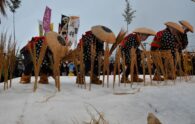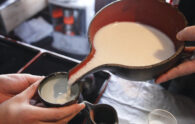Happy 2020! This year has us already buzzing with excitement as Nobel Laureate, Professors Higgs will be featuring at the ILC Symposium (remotely) in Tokyo next month and the Tokyo Summer Olympics will be commencing in July! And, in other news, foreign language studies will be made compulsory from grade 3 at elementary school and plastic bags will not be given out for free at the register anymore.
To kick off the year, I’d like to share how my friends and I spent New Year’s Eve and New Year’s Day in and around the ILC candidate site through some visuals.
Join us as we venture to UNESCO World Heritage site, Motsuji in Hiraizumi (Iwate Prefecture). Here we experience some traditional Japanese New Year’s Eve and New Year’s customs such as ‘toshikoshi soba’ (an auspicious noodle-dish eaten on NYE), Joya no Kane (a Buhddist ritual to remove the 108 worldly desires that mislead the body and soul) and ‘hatsumode’ (the first temple/shrine visit of the year).
On New Year’s morning, we set out for the port city of Kesennuma (Miyagi Prefecture) which neighbors Ichinoseki (Iwate Prefecture) for ‘hatsuhinode’ which is the tradition of watching the first sunrise of the year.

After staying up and driving around in the early hours of the morning, it’s time to feast on some ‘osechi ryori’. Osechi ryori are traditional foods enjoyed on New Year’s Day. Each of the delicately crafted dishes represent special wishes for the year and are packed into jubako, which look like bento boxes.
Dishes that often accompany osechi ryori include ‘mochi’ (sticky rice cake) and a soup called ‘ozoni’. Eating mochi is something that the locals in Ichinoseki and Hiraizumi are especially familiar with as it’s deeply embedded into the culture of the area –we can’t start the New Year without a piece or two!

The New Year period spans over many days (from Dec 29th ~ Jan 3rd); if you’re lucky like this year and connect the weekends, that’s a nine day holiday! To explore more on how people spend their time during this extended period of time, check out Anna’s article (https://www.iwate-ilc.jp/eng/ktimes/new-years-in-japan/).
Japanese
北上サイトで年越し明けましておめでとうございます。今年は楽しみなことがたくさんあります。
2月にはヒッグス博士がリモートにて出演する国際リニアコライダー推進国際シンポジウムが開催され、7月には東京オリンピックが開催されます。ほかにも、小学校3年生からの外国語の必修化や、スーパーやコンビニのレジ袋の有料化などが始まります。
2020年最初の記事では、友人と一緒に北上サイト周辺で過ごした大晦日と元旦をご紹介します。
私たちは世界遺産に登録されている、岩手県平泉町の毛越寺で大晦日を過ごしました。ここで「年越しそば」(大晦日に食べる縁起の良い麺料理)、除夜の鐘(多くの寺で108回撞かれる鐘で、「108」の数字は、怒りや妬み、物欲などの煩悩の数とされています。)や「初詣」(その年の最初の寺院/神社訪問)など、日本の伝統的な新年の習慣を体験したので紹介します。
[動画]
新年の朝、一関(岩手県)に隣接する気仙沼(宮城県)の港町に出かけ、日の出を見ました。この習慣は「初日の出」として知られています。
[写真]
朝早くから行動していましたので「おせち料理」を食べるのが楽しみです。
おせち料理は、お正月にいただく伝統的な食べ物です。 繊細に作られた食品の品揃えは、新年に関連した特別な意味を持ち、弁当箱のように見える重箱に詰められています。
おせち料理によく合わせる料理は、「もち」と「お雑煮」と呼ばれるスープです。餅を食べることは、一関と平泉の地元の人々にとって大事な食文化の一つなので、お正月にはぜひ食べたいものです。
人によりますが、お正月休みは数日間に渡ります(私たちの場合は通常12月29日~1月3日の6日間)。年によっては(カレンダーの曜日のめぐり合わせによっては)、今年のように週末につなげると9連休となります。 お正月についてもっと詳しく知りたい方は、K-TIMESバックナンバー(2019.2.21アンナさん作成記事)を御覧ください。
(https://www.iwate-ilc.jp/eng/ktimes/new-years-in-japan/).


-195x124.jpg)
